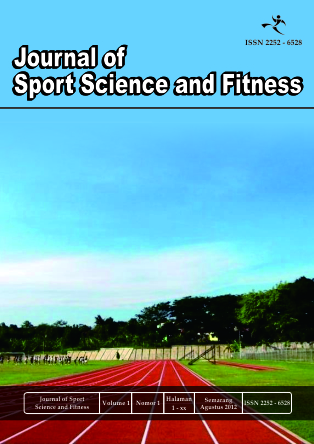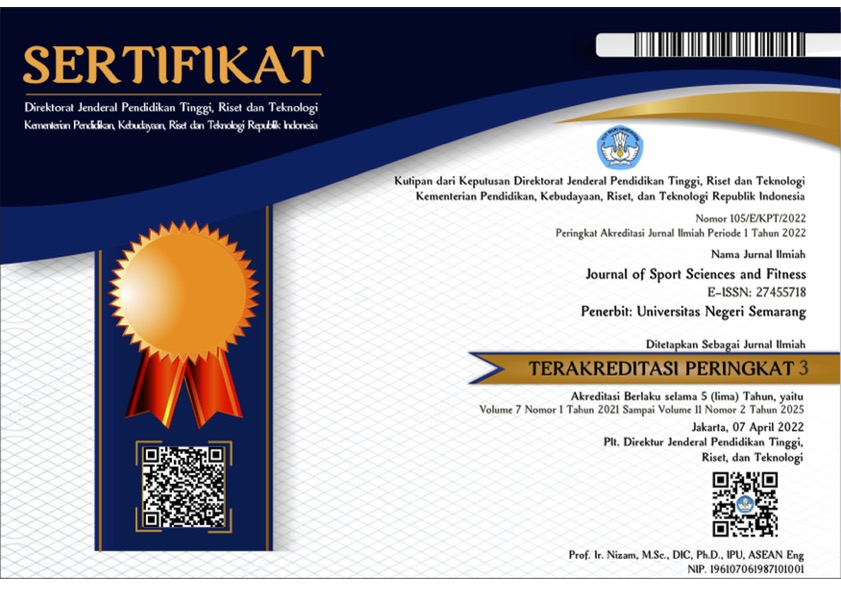FLEKSIBILITAS SENDI PANGGUL DAN PANJANG TUNGKAI TERHADAP HASIL SERVIS DAN SMES SEPAK TAKRAW
Abstract
Penelitian ini bertujuan untuk mengetahui besar sumbangan fleksibilitas sendi panggul dan panjang tungkai terhadap hasil servis dan smes sepak takraw. Penelitian ini termasuk penelitian survey test. Hasil penelitian 1) Sumbangan efektif fleksibilitas sendi panggul kecil (3,838%) terhadap hasil servis, 2) Sumbangan efektif panjang tungkai besar (21.570%) terhadap hasil servis, 3) Sumbangan efektif fleksibilitas sendi panggul besar (20.420%) terhadap hasil smes, 4) Sumbangan efektif panjang tungkai kecil (3.026%) terhadap smes, 5) Sumbangan efektif fleksibilitas sendi panggul dan panjang tungkai kecil (25,41%) terhadap hasil servis, dan 6) Sumbangan efektif fleksibilitas sendi panggul dan panjang tungkai kecil (23,45%) terhadap hasil smes. Simpulan penelitian : 1) sumbangan antara fleksibilitas sendi panggul dengan hasil servis kecil, 2) sumbangan antara fleksibilitas sendi panggul dengan hasil smes besar ,3) sumbangan antara panjang tungkai dengan hasil servis besar, 4) sumbangan antara panjang tungkai dengan hasil smes kecil, 5) sumbangan antara fleksibilitas sendi panggul dan panjang tungkai terhadap hasil servis kecil dan terhadap smes kecil.
Â
This study aims to determine the contribution of the flexibility of the hip joint and leg lengthon service outcomes and smash ball takraw. This research survey test. The results 1) Contribution Effective flexibility of the hip joint small (3.838%) of the results of the service, 2) Contribution Effective leg length large (21 570%) of the results of the service, 3) Contribution Effective flexibility of the hip joint large (20 420%) of the results smash, 4) Contribution Effective leg length small (3026%) of the results smash, 5) Contribution Effective flexibility of the hip joint and leg length small (25.41%)of the results of service, and 6) Contribution Effective flexibility of the hip joint and leg length small (23.45%) of the results smash. Conclusions of the study: 1) Contribution between the flexibility of the hip joint with the results of service small, 2) Contribution between the flexibility of the hip joint with the results of smash large, 3) Contribution between leg length with the result service large, 4) Contribution between leg length with the resultsof smash small, 5) Contribution between the flexibility of the hip joint and leg length of the result of service small and the results of smash small.
References
Suharsimi Arikunto. 2006. Prosedur Penelitian Suatu Pendekatan Praktik. Jakarta:PT. Rineka Cipta.
Sulaiman. 2008. Sepak Takraw. Semarang: Unnes Press.
Ratinus Darwis, dkk. 1992. Olahraga Pilihan Sepak Takraw. Jakarta: Depdikbud.
Vateh Al Amien. 2007. Sumbangan Kekuatan Otot Lengan Dan Panjang Lengan Terhadap Jauhnya Lemparan Atas Dalam Permainan Softball Pada Unit Kegiatan Mahasiswa Softball Putra Unnes Tahun 2007. Skripsi. Semarang: FIK Unnes.
Wisnu D. S. 2005. Latihan Smes Kedeng Antara Bola Digantung Dan DiumpanDengan Kaki Terhadap Kemampuan Smes Sepak Takraw Bagi Pemain Yunior Putera Klub Padang Jagad Kabupaten Demak Tahun 2005. Skripsi. Semarang: FIK UNNES. www.Scribd.com /doc/44978705/ skripsi-pendidikan, diakses pada tanggal 10 Mei 2012.
Didik S. P. R. 2012. Hubungan Antara Kecepatan Reaksi, Fleksibilitas Sendi Panggul, Dan Keseimbangan Dengan Hasil Sepak Mula Pada Permainan Sepak Takraw. Skripsi.Bandung: FPOK UPI. http://repository.upi.edu/skripsiview. php?noskripsi =11143








